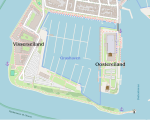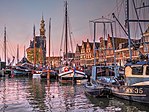Oostereiland
Artificial islands of the NetherlandsHoornLandmarks in the Netherlands

The Oostereiland in the Dutch city of Hoorn is an artificial island built between 1662 and 1668. It was constructed from dams which were then raised and broadened. Soon after construction, homes and warehouses were built on the island, including a warehouse for the Admiralty of the Noorderkwartier.
Excerpt from the Wikipedia article Oostereiland (License: CC BY-SA 3.0, Authors, Images).Oostereiland
Schuijteskade,
Geographical coordinates (GPS) Address External links Nearby Places Show on map
Geographical coordinates (GPS)
| Latitude | Longitude |
|---|---|
| N 52.634722222222 ° | E 5.0625 ° |
Address
Schuijteskade
1621 DE (Hoorn)
North Holland, Netherlands
Open on Google Maps










